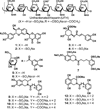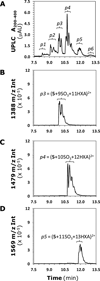Sulfated pentagalloylglucoside is a potent, allosteric, and selective inhibitor of factor XIa
- PMID: 23316863
- PMCID: PMC3574227
- DOI: 10.1021/jm301338q
Sulfated pentagalloylglucoside is a potent, allosteric, and selective inhibitor of factor XIa
Abstract
Inhibition of factor XIa (FXIa) is a novel paradigm for developing anticoagulants without major bleeding consequences. We present the discovery of sulfated pentagalloylglucoside (6) as a highly selective inhibitor of human FXIa. Biochemical screening of a focused library led to the identification of 6, a sulfated aromatic mimetic of heparin. Inhibitor 6 displayed a potency of 551 nM against FXIa, which was at least 200-fold more selective than other relevant enzymes. It also prevented activation of factor IX and prolonged human plasma and whole blood clotting. Inhibitor 6 reduced V(MAX) of FXIa hydrolysis of chromogenic substrate without affecting the K(M), suggesting an allosteric mechanism. Competitive studies showed that 6 bound in the heparin-binding site of FXIa. No allosteric small molecule has been discovered to date that exhibits equivalent potency against FXIa. Inhibitor 6 is expected to open up a major route to allosteric FXIa anticoagulants with clinical relevance.
Figures








Similar articles
-
Allosteric inhibition of factor XIa. Sulfated non-saccharide glycosaminoglycan mimetics as promising anticoagulants.Thromb Res. 2015 Aug;136(2):379-87. doi: 10.1016/j.thromres.2015.04.017. Epub 2015 Apr 22. Thromb Res. 2015. PMID: 25935648 Free PMC article.
-
Designing allosteric inhibitors of factor XIa. Lessons from the interactions of sulfated pentagalloylglucopyranosides.J Med Chem. 2014 Jun 12;57(11):4805-18. doi: 10.1021/jm500311e. Epub 2014 May 29. J Med Chem. 2014. PMID: 24844380 Free PMC article.
-
Discovery of Benzyl Tetraphosphonate Derivative as Inhibitor of Human Factor Xia.ChemistryOpen. 2020 Nov 10;9(11):1161-1172. doi: 10.1002/open.202000277. eCollection 2020 Nov. ChemistryOpen. 2020. PMID: 33204588 Free PMC article.
-
Factor XIa inhibitors: A review of the patent literature.Expert Opin Ther Pat. 2016;26(3):323-45. doi: 10.1517/13543776.2016.1154045. Expert Opin Ther Pat. 2016. PMID: 26881476 Free PMC article. Review.
-
Recent advances in the discovery and development of factor XI/XIa inhibitors.Med Res Rev. 2018 Sep;38(6):1974-2023. doi: 10.1002/med.21503. Epub 2018 May 4. Med Res Rev. 2018. PMID: 29727017 Free PMC article. Review.
Cited by
-
Allosteric inhibition of factor XIa. Sulfated non-saccharide glycosaminoglycan mimetics as promising anticoagulants.Thromb Res. 2015 Aug;136(2):379-87. doi: 10.1016/j.thromres.2015.04.017. Epub 2015 Apr 22. Thromb Res. 2015. PMID: 25935648 Free PMC article.
-
Allosteric Partial Inhibition of Monomeric Proteases. Sulfated Coumarins Induce Regulation, not just Inhibition, of Thrombin.Sci Rep. 2016 Apr 7;6:24043. doi: 10.1038/srep24043. Sci Rep. 2016. PMID: 27053426 Free PMC article.
-
Discovery of allosteric modulators of factor XIa by targeting hydrophobic domains adjacent to its heparin-binding site.J Med Chem. 2013 Mar 28;56(6):2415-28. doi: 10.1021/jm301757v. Epub 2013 Mar 18. J Med Chem. 2013. PMID: 23451707 Free PMC article.
-
Sulfotransferase and Heparanase: Remodeling Engines in Promoting Virus Infection and Disease Development.Front Pharmacol. 2018 Nov 22;9:1315. doi: 10.3389/fphar.2018.01315. eCollection 2018. Front Pharmacol. 2018. PMID: 30555321 Free PMC article. Review.
-
The In Vitro Effects of Pentamidine Isethionate on Coagulation and Fibrinolysis.Molecules. 2019 Jun 6;24(11):2146. doi: 10.3390/molecules24112146. Molecules. 2019. PMID: 31174390 Free PMC article.
References
-
- Henry BL, Desai UR. Anticoagulants: Drug discovery and development. In: Rotella D, Abraham DJ, editors. Burger’s Medicinal Chemistry. 7th ed. New York: John Wiley and Sons; 2010. pp. 365–408.
-
- Bates SM, Weitz JI. The status of new anticoagulants. Br. J. Haematol. 2006;134:3–19. - PubMed
-
- Hirsh J, Anand SS, Halperin JL, Fuster V. Guide to anticoagulant therapy: Heparin: a statement for healthcare professionals from the American Heart Association. Circulation. 2001;103:2994–3018. - PubMed
-
- Ansell J, Hirsh J, Hylek E, Jacobson A, Crowther M, Palareti G. Pharmacology and management of the vitamin K antagonists: American College of Chest Physicians. Evidence-based clinical practice guidelines, 8th ed. Chest. 2008;133:160S–198S. - PubMed
-
- Eikelboom JW, Wallentin L, Connolly SJ, Ezekowitz M, Healey JS, Oldgren J, Yang S, Alings M, Kaatz S, Hohnloser SH, Diener H-C, Franzosi MG, Huber K, Reilly P, Varrone J, Yusuf S. Risk of Bleeding With 2 Doses of Dabigatran Compared With Warfarin in Older and Younger Patients With Atrial Fibrillation. An analysis of the randomized evaluation of long-term anticoagulant therapy (RE-LY) Trial. Circulation. 2011;123:2363–2372. - PubMed
Publication types
MeSH terms
Substances
Grants and funding
LinkOut - more resources
Full Text Sources
Other Literature Sources
Chemical Information

